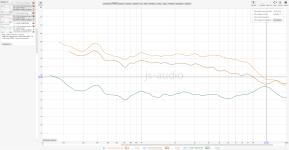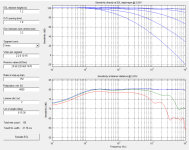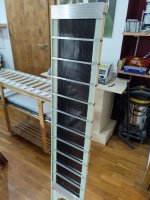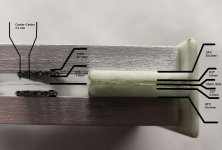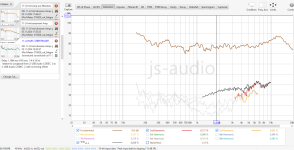The mass of air can't damp alone! See the huge, undamped basal resonance of full range ESLs! The damping come from ohmic component of radiation impedance, which dominate at higher frequencies. Of course, you are rigt: the air mass greater than membrane mass (always). The mass alone gives only inductive component of complex load impedance, not the damping.Thus super light membrane is damped by the mass of air, because the mass of air is greater than the mass of the adjacent membrane.
To reproduce many low frequencies and most importantly to create a sound wave corresponding to this frequency, the physical body of the transmitter must match the length of the sound wave.
An example is the pipes of an organ.
An example is the pipes of an organ.
The mass of the membrane we choose ourselves, I, for example, use a membrane thickness of 2 microns in the HF, but in the woofer where the area of membranes 50/50cm I use a membrane thickness of 12 microns.The mass of air can't damp alone! See the huge, undamped basal resonance of full range ESLs! The damping come from ohmic component of radiation impedance, which dominate at higher frequencies. Of course, you are rigt: the air mass greater than membrane mass (always). The mass alone gives only inductive component of complex load impedance, not the damping.
Of course, if you use a 30 or 50microns thick diaphragm, its weight may be critical for air damping.
Indeed, almost right... But, only if we comparise with conventional, conical dynamic drivers. But unfortunately, the ESLs hasn't full immunity too...The thing is that "structural resonances" occur on a plane (membrane) which is activated in one or more places, but the value of electrostatic is that it is activated by a whole, continuous electrostatic field, there are no areas where the activation is more or less.
https://www.researchgate.net/figure...quencies-of-the-electrostatic_fig10_275662673
Not true again... The thicker foil's mass still neglible too - compared the coupled moving air mass. The membrane thickness can be critical for the high frequency roll off, but not at basal resonance.Of course, if you use a 30 or 50microns thick diaphragm, its weight may be critical for air damping.
If we can hear a lot of pipe organ music and orchestra, all of us have a mesmeric illusions?To reproduce many low frequencies and most importantly to create a sound wave corresponding to this frequency, the physical body of the transmitter must match the length of the sound wave.
A thicker membrane will be more rigid, and a rigid surface is preferable for HF radiation.Not true again... The thicker foil's mass still neglible too - compared the coupled moving air mass. The membrane thickness can be critical for the high frequency roll off, but not at basal resonance.
And yes, I tried all this, the HF on a thick membrane is no less, but they are much more colored, that is, the inertial mass matters.
Last edited:
Organ music has a relation to hypnosis, but only insignificantly. Above we discussed the piston mode of the emitter, so I remembered the pipes of the organ so that low frequencies can be obtained without the piston mode, but then you need to remember the “physical law” that in order to to create a sound wave at 30 Hz, we will need a physical body measuring 11.4 meters, that is, a size corresponding to the length of the sound wave at 30 Hz.
Hi,
sorry to also say; "havun You erred on several points" ... well, in fact all points that nedymium ´complained´ about.
Not mentioned by him is "never use double-sided tape".
Just looking at the portfolio of tapes from 3M one can see, that just as with finding the right glue for the associated joining partner materials it is crucial to find the right tape.
I had no probs with relaxing diaphgragms due to thin double-sided tape in my flat wire-stators utilizing PVC as spacers and a TESA carpet tape with mostly thermal tensioning of the membrane.
I have also none of the claimed probs using 3M tapes (some black ones as well as the clear ones) in my curved sheet metal stators (with a top insulating layer of PU-laquer) at much higher mechanical membrane tension.
Actually I once asked 3M service for a procedure to remove those tapes ... they answered they didn´t knew a practical and non-distructive one.
Again: choosing the right glue or choosing the right tape and choosing the right application procedure will result in a highly durable, lasting glue joint.
jauu
Calvin
ps. fortunately neodymium released us others from debunking Your false claims.
#15: claim: flat stator requires more excursion due to reduced piston mode ... No, but towards high frequencies moving towards a kindof pistonic mode.
#18: claim: no piston mode no LF-output ... No again. Nature provides us with several different excitation modes, not just pistonic ... which as I think of it is probabely the least used by nature.
#19: claim: ESL-field, there are no areas where the activation mode is more or less ... Not true, the area close to the suspension is just one.
I suggest as reading: Mr. Streng´s papers about charge movement on stretched membranes, and/or sound radiation from circular membranes, and others.
Hi,
edit: unfortunately the response to claims #22, #27 and #28 vanished somehow in the depths of the system ... just in short: those claims are also resting on very thin ground.
sorry to also say; "havun You erred on several points" ... well, in fact all points that nedymium ´complained´ about.
Not mentioned by him is "never use double-sided tape".
Just looking at the portfolio of tapes from 3M one can see, that just as with finding the right glue for the associated joining partner materials it is crucial to find the right tape.
I had no probs with relaxing diaphgragms due to thin double-sided tape in my flat wire-stators utilizing PVC as spacers and a TESA carpet tape with mostly thermal tensioning of the membrane.
I have also none of the claimed probs using 3M tapes (some black ones as well as the clear ones) in my curved sheet metal stators (with a top insulating layer of PU-laquer) at much higher mechanical membrane tension.
Actually I once asked 3M service for a procedure to remove those tapes ... they answered they didn´t knew a practical and non-distructive one.
Again: choosing the right glue or choosing the right tape and choosing the right application procedure will result in a highly durable, lasting glue joint.
jauu
Calvin
ps. fortunately neodymium released us others from debunking Your false claims.
#15: claim: flat stator requires more excursion due to reduced piston mode ... No, but towards high frequencies moving towards a kindof pistonic mode.
#18: claim: no piston mode no LF-output ... No again. Nature provides us with several different excitation modes, not just pistonic ... which as I think of it is probabely the least used by nature.
#19: claim: ESL-field, there are no areas where the activation mode is more or less ... Not true, the area close to the suspension is just one.
I suggest as reading: Mr. Streng´s papers about charge movement on stretched membranes, and/or sound radiation from circular membranes, and others.
Hi,
edit: unfortunately the response to claims #22, #27 and #28 vanished somehow in the depths of the system ... just in short: those claims are also resting on very thin ground.
Attachments
-
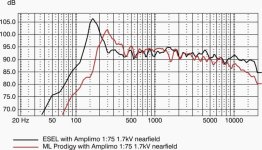 ESL-Prodigy Vergleich.jpg70.4 KB · Views: 87
ESL-Prodigy Vergleich.jpg70.4 KB · Views: 87 -
Streng, charge movements on a stretched membrane in a circular esl.pdf628.4 KB · Views: 90
-
Streng, sound radiation from circular stretched membranes in free space.pdf961.2 KB · Views: 160
-
Streng; calculation of the surface pressure on a vibrating circular stretched membrane in free...pdf575.8 KB · Views: 107
Calvin
Hello, unfortunately you have not refuted a single “my” point.I’ll tell you a little of my own story, in order to tension the membrane to a stator size of 2/0.4 meters, I had to build a tensioning device, the tension along the length was 20 kg, across the width 5 kg, you can’t do that using any thermal method, but the problem here is precisely that fix the film in this position, there is a problem with the glue, I found it.
Upon activation of the membrane, it is activated absolutely evenly over the entire area, another thing is how it reacts to activation in the center and at the edge, it is clear that in the center the membrane will experience the greatest piston mode.
It was on this occasion that I reminded that the membrane-stator gap in a rectilinear stator design should be greater than that of a curved stator of the Martin Logan type.
But accordingly, the low frequency will be greater for a rectilinear emitter for reasons that are understandable to all.
What did I write that was unclear to you?
Hi,
I certainly don´t regard me as ´all´.
So please feel free to explain it in simple technical wording why a plane stator requires more d/s than a curved one.
I´m coming to age and have probabely already forgotten more about ESLs than others may ever learn ... but hey, I try to be open for fresh thinking and ideas 😉
jauu
Calvin
ps. havun: be assured I´m following Your ESL-project with positive interest, because I find it´s such a refreshingly different design to most others. 👍
I certainly don´t regard me as ´all´.
So please feel free to explain it in simple technical wording why a plane stator requires more d/s than a curved one.
I´m coming to age and have probabely already forgotten more about ESLs than others may ever learn ... but hey, I try to be open for fresh thinking and ideas 😉
jauu
Calvin
ps. havun: be assured I´m following Your ESL-project with positive interest, because I find it´s such a refreshingly different design to most others. 👍
+ me!ps. havun: be assured I´m following Your ESL-project with positive interest, because I find it´s such a refreshingly different design to most others. 👍
No more lion roar, only python roar! (The lion isn't enough big for its sound, only the python. But why audible the lion roar from 5km distance? The lion don't read diyAudio?)to create a sound wave at 30 Hz, we will need a physical body measuring 11.4 meters, that is, a size corresponding to the length of the sound wave at 30 Hz
The modelling is clever step of your ESL's development. I see the wanted speaker. Nice! If you needn't a few little electric shock😉, I suggest, the aluminium crossbars connection to the earth potential, via resistors (cca. 1-10M). You can take 2-3 mm thick insulator between crossbars and wires. This causes reduction of parasitic capacitances (better efficiency and freq. response), especially, if the insulator is low permittivity (nonporous polystyrene or hard PVC foam plate).What do you think about our new design? Do you have any suggestions for improvement?
The T-shaped GFK jigs or calipers give a chance for correction of membrane stretching (spacer between jigs and crossbar ends or implementation of threaded mechanism.
Unfortunately, the stators are resonators, but damped and coupled resonators (at "best case scenario").Aren't the stators of an electrostat,resonators?
I think my head is resonating. As far as I can tell, this is a full-page diversion that has nothing to do with the original poster's questions, interests, etc.
Hi all,
it took some time but here i am again....
In the meanwhile a lot of things happened.
I had to move my workshop, summer holidays, some throwbacks and so on...
But now we finished our first stator, measured it and also tried it out with some bass speakers...
Even if the sound was really amazing, i am not sure if we should be happy with the measuring results...
Above 10 kHz we seem to have a loss of highs. The measurement was taken in a big room with the mic in different distances (10cm, 1m 2m) all with simillar results.
The first measures were taken with four toroids (153:1) including a 2 Ohm resistor.
Then we tried several amps (all of them Class-D which are not ideal for ESL what people say...).
Finally we measured with only two toroids (76:1) plus a 1 Ohm resistor.
For me this curve looks better than the first ones.
What do all the specialists out there say?
To be honest we don't know about the bias voltage since we use an adjustable HV-supply and we can't measure HV since my multimeter can only handle up to 1000V...
The d/s spacing is 1,8 mm, wire/wire is 3.2mm... There is also a simulation attached...
Despite of anything we are very happy to get the first panel playing.
Anyway, a lot of things have to be done and a lot of questions are still open....
But like the French say: "C'est la vie"....
it took some time but here i am again....
In the meanwhile a lot of things happened.
I had to move my workshop, summer holidays, some throwbacks and so on...
But now we finished our first stator, measured it and also tried it out with some bass speakers...
Even if the sound was really amazing, i am not sure if we should be happy with the measuring results...
Above 10 kHz we seem to have a loss of highs. The measurement was taken in a big room with the mic in different distances (10cm, 1m 2m) all with simillar results.
The first measures were taken with four toroids (153:1) including a 2 Ohm resistor.
Then we tried several amps (all of them Class-D which are not ideal for ESL what people say...).
Finally we measured with only two toroids (76:1) plus a 1 Ohm resistor.
For me this curve looks better than the first ones.
What do all the specialists out there say?
To be honest we don't know about the bias voltage since we use an adjustable HV-supply and we can't measure HV since my multimeter can only handle up to 1000V...
The d/s spacing is 1,8 mm, wire/wire is 3.2mm... There is also a simulation attached...
Despite of anything we are very happy to get the first panel playing.
Anyway, a lot of things have to be done and a lot of questions are still open....
But like the French say: "C'est la vie"....
Attachments
- Home
- Loudspeakers
- Planars & Exotics
- ESL Newbie questions...
